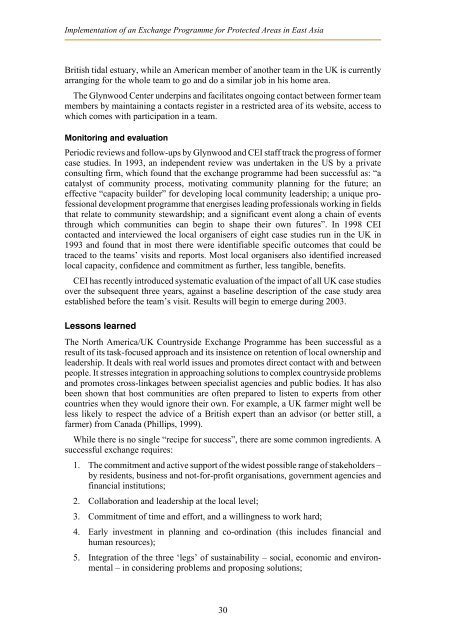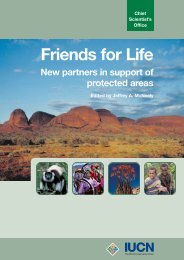Exchange programmes - IUCN
Exchange programmes - IUCN
Exchange programmes - IUCN
You also want an ePaper? Increase the reach of your titles
YUMPU automatically turns print PDFs into web optimized ePapers that Google loves.
Implementation of an <strong>Exchange</strong> Programme for Protected Areas in East Asia<br />
British tidal estuary, while an American member of another team in the UK is currently<br />
arranging for the whole team to go and do a similar job in his home area.<br />
The Glynwood Center underpins and facilitates ongoing contact between former team<br />
members by maintaininga contacts register in a restricted area of its website, access to<br />
which comes with participation in a team.<br />
Monitoring and evaluation<br />
Periodic reviews and follow-ups by Glynwood and CEI staff track the progress of former<br />
case studies. In 1993, an independent review was undertaken in the US by a private<br />
consulting firm, which found that the exchange programme had been successful as: “a<br />
catalyst of community process, motivatingcommunity planningfor the future; an<br />
effective “capacity builder” for developinglocal community leadership; a unique professional<br />
development programme that energises leading professionals working in fields<br />
that relate to community stewardship; and a significant event along a chain of events<br />
through which communities can begin to shape their own futures”. In 1998 CEI<br />
contacted and interviewed the local organisers of eight case studies run in the UK in<br />
1993 and found that in most there were identifiable specific outcomes that could be<br />
traced to the teams’ visits and reports. Most local organisers also identified increased<br />
local capacity, confidence and commitment as further, less tangible, benefits.<br />
CEI has recently introduced systematic evaluation of the impact of all UK case studies<br />
over the subsequent three years, against a baseline description of the case study area<br />
established before the team’s visit. Results will begin to emerge during 2003.<br />
Lessons learned<br />
The North America/UK Countryside <strong>Exchange</strong> Programme has been successful as a<br />
result of its task-focused approach and its insistence on retention of local ownership and<br />
leadership. It deals with real world issues and promotes direct contact with and between<br />
people. It stresses integration in approaching solutions to complex countryside problems<br />
and promotes cross-linkages between specialist agencies and public bodies. It has also<br />
been shown that host communities are often prepared to listen to experts from other<br />
countries when they would ignore their own. For example, a UK farmer might well be<br />
less likely to respect the advice of a British expert than an advisor (or better still, a<br />
farmer) from Canada (Phillips, 1999).<br />
While there is no single “recipe for success”, there are some common ingredients. A<br />
successful exchange requires:<br />
1. The commitment and active support of the widest possible range of stakeholders –<br />
by residents, business and not-for-profit organisations, government agencies and<br />
financial institutions;<br />
2. Collaboration and leadership at the local level;<br />
3. Commitment of time and effort, and a willingness to work hard;<br />
4. Early investment in planningand co-ordination (this includes financial and<br />
human resources);<br />
5. Integration of the three ‘legs’ of sustainability – social, economic and environmental<br />
– in consideringproblems and proposingsolutions;<br />
30






